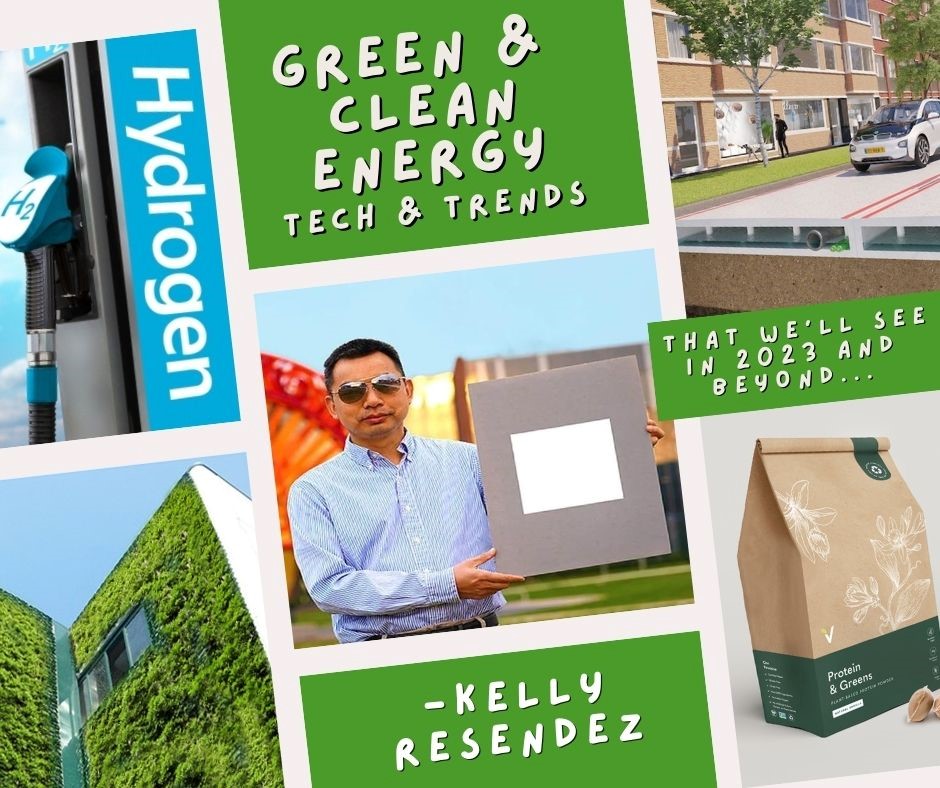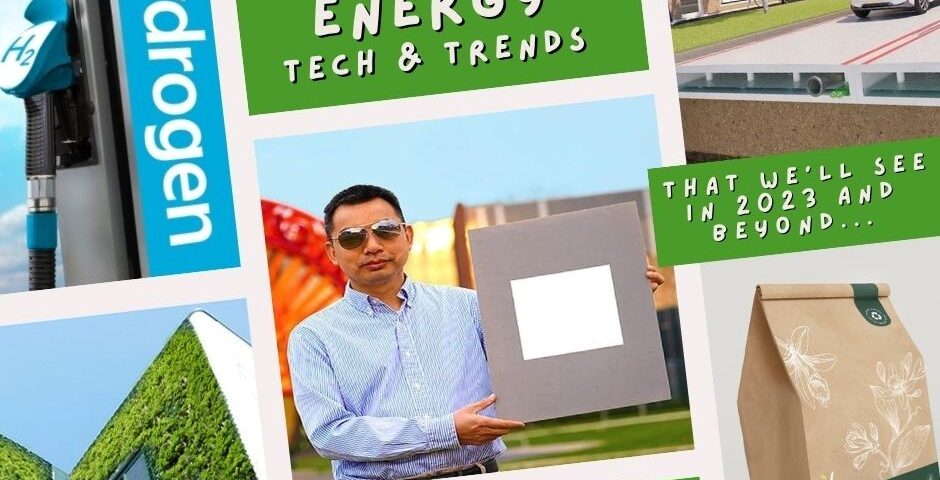
Solar tech and trends we’ll see in 2023 and beyond.
January 15, 2023
Exploring the life-changing power of habits.
March 15, 2023
Last month, I documented some of the latest and greatest trends in solar power, including solar tech and trends we’ll see in 2023 and beyond.
Of course, there are a host of exciting advancements in clean and renewable energy outside of solar, as well as green innovations that will soon be part of our daily lives.
But I can’t stress enough the importance of pushing these innovations forward. To protect our planet and way of life, we must develop low-cost green and clean energy sources, drastically reduce the prevalence of pollutants as well as reverse global warming.
For instance, we recently hit an auspicious milestone when the level of CO2 (carbon dioxide) reached 150% of its concentration during preindustrial times. To counter this, scientists and researchers are calling for a decrease of net emissions to zero by 2050.
The good news is that we’re on our way. McKinsey research points to the fact that by 2026, the global capacity to generate renewable electricity will be 80% higher than we saw just a few years ago in 2020.
So, to follow up on my previous blog about solar innovations, today I will cover 10 of those green & clean energy tech and trends we’ll see in 2023 and beyond.
1. The whitest paint ever created.
Researchers have invented what they call “the whitest paint ever created” – an ultra-white surface covering that reflects about 98.1 percent of the sun’s rays.
Ordinary white paint does stay marginally cooler than other colors that absorb more sunlight and heat up faster. But ultra-white paint includes barium sulfate that reflects ultraviolet light, helping to cool surfaces and therefore reducing the need for air conditioning in homes or buildings.
Scientists have been working on these white/reflective paints since the 1970s, but recent developments by researchers at MIT seem to have perfected the process, creating a paint that will help us reduce surface temperatures, cool downtowns and high-density building areas, and aid our efforts to reverse global warming.
Paint is on just about every exterior surface, and now we can cover it with the whitest paint ever created!
2. Low-carbon construction
Did you know that 38% of all greenhouse gas emissions around the world come from buildings and construction?
But the trend of low-carbon construction, using eco-friendly materials like hemp and bamboo, is turning them smart and sustainable. Not only do low-carbon construction projects emit very little carbon, but they require far less heating or cooling, generate less pollution, less waste, and usually are equipped to generate their own energy, such as through rooftop solar panels.
3. Carbon capture and storage
Our overriding goal is to keep the globe’s temperature increase below 1.5°C. To do that, we need to not only reduce our carbon usage but actually pull existing carbon from the earth’s atmosphere. Thanks to carbon capture technology, that’s now possible.
The carbon capture (and storage) process entails extracting carbon from the atmosphere and converting it to synthetic fuel. Right now, the high cost and small magnitude of carbon capture don’t qualify it as a viable option for cooling our planet, but that can and will change very soon.
4. Improved storage capacity for renewable energy
Renewable energy has made great strides in recent years, but one key logjam is still in storing generated energy, which keeps it from being available consistently. Some days the sun doesn’t shine, the wind doesn’t blow, and the waves don’t…well, wave, which reduces the viability of on-demand clean energy generation.
Thankfully, a host of scientists, designers, and firms around the world are working on that problem, rapidly innovating long-term storage technology for renewable energy, and the improvements in batteries and storage efficiency will really give the industry a monumental boost.
5. Hydrogen-powered cars
Electric cars have gained mainstream popularity – but are also running into challenges and setbacks. However, another type of clean transportation may soon match and even exceed the prevalence of electric vehicles, and that’s hydrogen-powered vehicles.
The huge advantage of a hydrogen power source is that it doesn’t require a battery like with electric cars. Hydrogen is far more efficient and can run further and cleaner, although the cost is now prohibitive. However, hydrogen vehicles are already in production in certain parts of the world, and it’s estimated that by 2050, there will be more than 400 million hydrogen-powered cars and buses on the roads – and in the skies!
6. Plastic Roads
Our overabundance of plastic waste is literally choking the oceans and poisoning our lands. But some of that discarded plastic can go to good use by using it to construct “plastic roads.” There are actually two ways to integrate plastics into road building: using only plastic or mixing it into asphalt.
Plastics from consumer waste are used to prefabricate hollow modular blocks that are linked together to form Plastic Roads. They are still in development and testing in such places as Holland. But, once refined, they will reduce the traditional carbon footprint of building roads by 50-72%, as well as being more durable and lasting longer than traditional roads.
7. Circular waste management (upcycling)
With more than 8 billion people on the planet (as of November 2022), the amount of waste and garbage produced is at an almost-incalculable level, and that’s especially true in rich, developed countries like the United States.
All of that trash needs to go somewhere and be stored safely while it decomposes, so upcycling is an emerging movement that looks to make a huge difference.
Although far from glamorous like other clean and green tech, we can convert waste into new, usable products and materials, as well as create fuels, fertilizers, etc., that can keep a circular economy thriving, solving several profound global issues at once.
8. Green Walls
Utilizing rooftops to add solar is often in the conversation when we’re talking about energy conservation, but the potential to create plant or green walls is just as promising. After all, every building, structure, and home has plenty of walls, and there are a whole lot more of them than roof spaces (to state the obvious).
Green walls are simply any vertical building element that allows plants, flowers, or vines to grow. They can be integrated into a home’s design in small part, like in one wall of a shower or an inviting green entryway, or wrap a complete outside of a building. Smart technology is being used more to keep living walls lush and thriving, integrating soil and watering systems.
Adding plant life to normal unused walls taps into the potential for air purification, capturing rainfall that might otherwise contribute to flooding, lowering air temps in urban centers, and is proven to reduce stress and improve focus in work settings or homes.
9. Plant-based packaging & bottles
The over-abundance of plastics is creating great harm to our environment, and viable solutions have lagged far behind that of other climate challenges.
But technology is emerging to create the packaging we need out of plant-based materials. Called polyethylene furoate (PEF), it’s created from bio-feedstocks like sugar waste, straw, cornstarch waste, etc.
These allow us to create plastics that are 100% biodegradable as well as recyclable, and studies have shown that switching to these plant-based plastics could reduce greenhouse gas emissions by 45-55% worldwide!
10. Cool pavement
All of our roads, highways, and parking lots heat up under the sun, creating what’s called the urban heat island effect. In cities and urban centers, the average temperature can reach up to 10°F higher just because of all of that pavement.
While traditional asphalt and concrete absorb about 60-95% of the heat from the sun’s rays, “cool pavement” may solve that problem – and help us cool down our metro areas. Instead of traditional materials, special additives or mixtures are added to blacktops and roads that help reflect the sun’s rays.
Cool pavements can reduce the air temperature in cities by about 1°F (a huge change with significant benefits), improve air quality, and help stem the negative effects of climate change.
***
The future is bright, cleaner, and cooler with these green tech and trends for 2023 and beyond!




